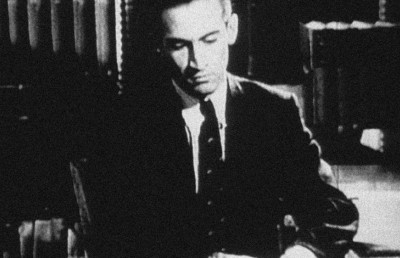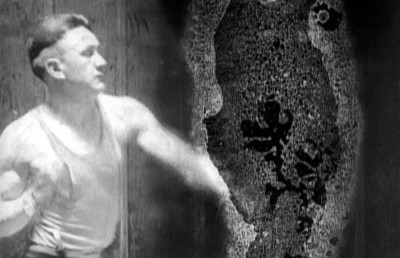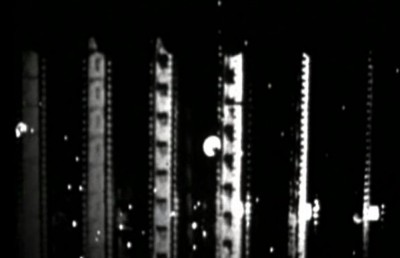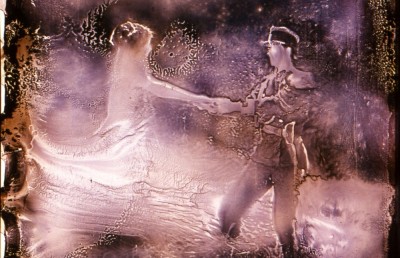This Film is Dangerous: A Celebration of Nitrate Film
Preserving the Past
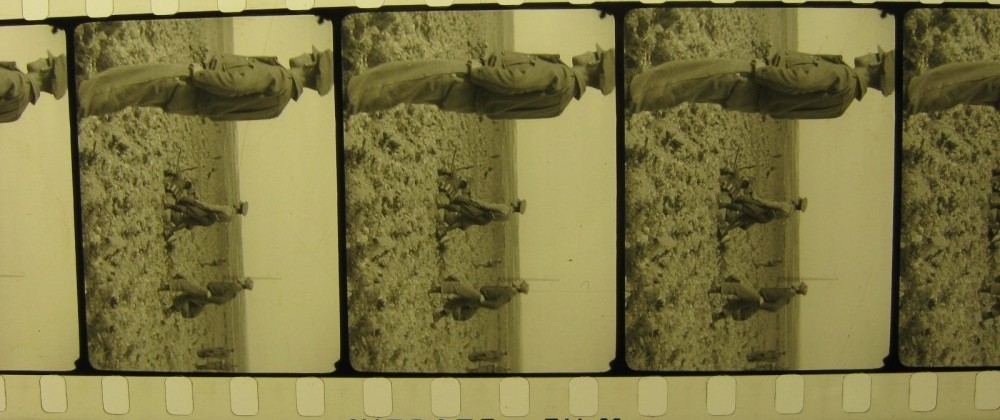
This Film is Dangerous: A Celebration of Nitrate Film, ed. Roger Smither, Associate editor Catherine A Surowiec. FIAF (Fédération Internationale des Archives du Film), London: United Kingdom, 2002.
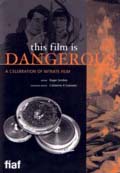
One of the most impressive publishing endeavors in the area of film scholarship in recent years is the mammoth nine-year undertaking which resulted in this 720 page tome, This Film is Dangerous: A Celebration of Nitrate Film. This book is a celebration of early cinema heritage and the people who know about, care, preserve, and love the fifty (or so) year history of nitrate cinema, ostensibly the years before the film industry instituted a wholesale change from using nitrate film stock to safety triacetate film stock (1895-1951). As Martin Scorsese says in his introduction, “This book is their story.” The book is an outgrowth of FIAF, the International Federation of Film Archives, which was founded in 1938 and now “brings together more than 120 institutions in over 60 countries.” 1 I recommend a visit to the FIAF website, where you can learn more about the organization and, surprisingly, access full text versions of the Federation’s excellent Journal of Film Preservation.
The issues surrounding the preservation of the volatile and flammable nitrate film are many. There are of course such obvious issues as economics and funding, storage, selection, accessibility, safety, etc. But there are other less obvious issues (all of which are dealt with in the book): Should the original nitrate print be preserved or destroyed after it has been copied over to safety acetate? Should nitrate films be screened and if so to whom and under what conditions? How do we ensure that the original tinting and toning in the nitrate print is eventually carried over to the safety acetate copy?
When it comes to philosophy of nitrate preservation, there are two general positions. On the one hand, especially with the fairly recent realization of safety triacetate stock’s own fallibility (vinegar syndrome, color loss, and shrinkage, a problem with all film stocks that are improperly preserved), there is a push to preserve the nitrate films which are still in good condition, so that the particular aesthetic properties of nitrate can survive (the luminous sparkle and greater range in blacks and greys, largely due to its silver content), or simply transferring nitrate prints to safety acetate to preserve the filmic history.
One of the fascinating aspects of this book, which sets it apart from the usual academic book, is its looser format structure which allows for texts which range from a paragraph to several thousand words, and involves contributors from a vast variety of fields. Many of the contributors are FIAF members with a well-known reputation in the area of film history, archiving, and preservation. Hence one is not surprised to see the names of Kevin Brownlow, Eileen Bowser, Stephen Bottomore, Michael Chanan, Paolo Cherchi Usai, Jan-Christopher Horak, and David Robinson. But alongside these better known academic names are people from a variety of technical and scientific backgrounds (laboratory technicians, scientific data handling, vault technicians, projectionists), filmmakers (Orson Welles, Richard Attenborough, Helen Van Dongen, Richard Leacock), and film collectors. Another of the book’s strengths is its vast national representation. We don’t just get information on North American and West European archive and history, but both personal and more scholarly accounts from Israel, Australia, East Europe, Egypt, India, The Republic of Korea, Iran, Japan, New Zealand, and China.
The book is divided into ten sections. The longest and most academically rigorous section takes its title from a symposium held in June 2000 entitled “The Last Nitrate Picture Show,” and includes a selection of papers from that event. This section includes a detailed account of the invention of celluloid by Deac Rossell (“Exploding Teeth, Unbreakable Sheets, and Continuous Casting: Nitrocellulose, from Guncotton to Early Cinema”), a highly technical account of film preservation strategies by Jean-Louis Bigourdan (“From the Nitrate Experiment to New Film Preservation Strategies”), and a fascinating chronicle of the history and evolution of the idea of film preservation by Stephen Bottomore (“The Sparkling Surface of the Sea of History”-Notes on the Origins of Film Preservation”), which Bottomore dates as beginning in 1898. The succeeding section is also scholarly in approach, “The Silver Lining,” which is composed of original essays which were squeezed out of the above mentioned conference because of tight scheduling, and papers submitted directly to this book. The section “Everyday Nitrate” includes original contributions and reprinted material centered on cinema professionals and amateurs. The pieces in this section are generally shorter, more informal, and personal.
According to the informed opinions of cinema professionals in the book, the conditions under which nitrate film could catch fire include extreme heat (as low as 40-45 degrees Celsius, from either a projector, lamp, light, sun, or other source), contact with a sparking agent (cigarette, electrical spark, etc.), and extreme friction (i.e. from wooden guides on rewinders). The concern for fires was generally of two source types: fires in screening venues (theatres, playgrounds, nickelodeons, etc.) and fires in places where nitrate films were housed (archives, museums, attics, garages, theatre storage areas, etc.). The danger and volatility of nitrate film has led to some remarkable stories and tall tales throughout the years, including some that have reached the proportion of myth. One such is the history surrounding Robert Flaherty’s Nanook of the North..
Richard Leacock, who filmed Robert Flaherty’s Louisiana Story (on nitrate but transferred over to safety stock to edit) reminds us of the prophetic story behind the destruction of the first version of Nanook of the North. Flaherty was in the laboratory working on the development of the film. A flickering cigarette flame fell onto the nitrate stock and the whole film and laboratory blew up in flames. Or so the story goes. Leacock recounts, “He [Flaherty] told me that his clothes were on fire so he ran out on to the street, where the local chemist knocked him down and put him out.” 2 In a later section of the book the documentary filmmakers D.A. Pennebaker offers another interpretation of the “Nanook” fire, suggesting that Flaherty did not like the first version of the film and destroyed it himself, then made up the story of the fire so that the sponsors would still put up more money. (p. 517).
The book dedicates a whole section to fire and nitrate film, “The Cost of Nitrate.” Several essays take a countering position by arguing that nitrate was not as dangerous as the mythology suggests. One of the more well-informed of these essays is by film archivist Sam Kula, “Mea Culpa: How I Abused the Nitrate in my Life.” Kula goes over many of the more famous fires that have occurred over the years and demonstrates that in each case human error or incompetence was the cause of the fire. Kula brings in an army of statistics and figures relating to the millions of nitrate feet that passed through projector gates during the period, often under less than ideal projecting conditions, the haphazard way that nitrate film was transported and stored, and the millions and millions of viewers that attended nitrate screenings. Kula’s point being that, in fact, nitrate was a viable and durable workhorse the world over, and is unjustly remembered (and not without political implications) as a “dangerous and volatile” film stock. Other “anti-alarmists” include, from India, P K Nair’s “Not So Dangerous: Some Recollections,” Paolo Cherchi Usai’s “An Epiphany of Nitrate,” and Roger Smither and Catherine A Surowiec’ balanced overview of the nitrate and fire issue, “Calamity Howlers”: An Introduction.”
This introductory piece is followed by a chronological listing of some of the more well know fires that have weaved their way into the fabric of “the established history and folklore of cinema…” (429). The listing includes the famous fire in the Laurier Palace Cinema in Montreal on January 9, 1927, where a small fire in the projection booth caused a panic that saw 77 children aged between 4 and 18 die of suffocation or injury caused by being crushed in the crowd rush. Amazingly, the event led to a bylaw in Quebec that prohibited children under 16 from attending the cinema, a ban which lasted until 1967!
Granted that many of the nitrate fires were caused by human error or incompetence, but the bottom line is that in most if not all of those cases, the same human error would not have led to a fire if the stock had been safety acetate. Another source of potential danger is nitrate housed by people who don’t quite know what they have. Jan-Christopher Horak relates a story where he went to someone’s house as follow-up to a phone call and was shown a pile of 35mm nitrate cans neatly stacked up against an oil-burning furnace! So while the verdict is still out on the long term stability of safety acetate versus nitrate, and in fact many of the accounts suggest that nitrate has a better preservation track record, there is little doubt that nitrate was, all things considered equal, a much more dangerous film stock than safety acetate.
Two essays discuss one of the most important and unique nitrate film finds in North America, the Dawson City discovery of 1978. Sam Kula’s “Up from the Permafrost: The Dawson City Collection,” is an extensive analysis of the discover and recovery of the 533 reels of film that were stored for 49 years in a swimming pool which was boarded up and paved as a hockey rink, in Dawson City in the Yukon Territory. The condition of the films, mainly newsreels, serials, and productions from smaller American studios (Thanhouser, 101-Bison, Selig, Essanay), ranged from very near perfect to beyond salvage. The films were stored in the swimming pool in 1929, discovered in 1978, and by 1984, transferred to safety acetate with the help of the Library of Congress. A second essay, “The Library of Congress and its ‘Nitrate Problem’” by Paul C. Spher, mentions in passing the Dawson City find as it relates to its own nitrate history.
The section entitled “Luminous Impressions” is a fascinating selection of restoration projects involving nitrate films which gives evidence to the eclecticism and resourcefulness often necessary in the world of nitrate film preservation. In “A Melody Lost in 1939…” writer Sakari Toiviainen recounts the efforts of Finnish film researcher Lauri Tykkyläinen in tracking down and restoring the film legacy of the Finnish director Nyrki Tapiovaara, who died at the young age of 28 in 1940 during the Winter War. Tykkyläinen managed to restore 43 minutes of a 76 minute film entitled Herra Lahtinen lähtee lipettiin (Mr. Lahtinen Takes French Leave, 1939). His description of the film and the two stills we see from it makes one eager at the prospect of fully recovering the film. The title of the essay refers to Nyrki Tapiovaara’s lost masterpiece, The Lost Melody (1939), which Tykkyläinen hopes will one day be discovered.
In the following section “When Time Ran Out…” we learn of the unusual yet successful projects initiated first by Australia in 1981 (lasting five years) and then New Zealand in 1992 (lasting seven years), to conduct a nation-wide search for nitrate film spanning people’s houses, garages, attics, storage rooms, theatres, etc. Both projects were billed “The Last Film Search” and were extremely successful, with Australia finding over one million feet of nitrate film, and New Zealand finding 8000 films. Another interesting and little known nitrate project is described by one of its facilitators, Ann Baylis, in the self-explanatory title, “Nitrate Film Repatriation: a diplomatic experience.” This program was initiated by the New Zealand Film Archive (Jonathan Dennis) and MOMA (Eileen Bowser) and, saw over 5000 cans of film repatriated to their country of origin between the years 1989-1994. The countries involved were Australia, New Zealand, Canada, France, Germany, and the United Kingdom. Some of the more well known titles to be included in the intercontinental swaps were, returning to Australia, Raymond Longford’s The Sentimental Bloke 1919; returning to the United States, Harold Lloyd’s Once Every Ten Minutes and Peculiar Parents’ Pranks (both 1915), the Mack Sennett/Charley Chase comedy Bringin’ Home the Bacon (1924), and Maurice Tourneur’s Alias Jimmy Valentine (1915), and returning to Canada, Vancouver (1907) and A Canadian Winter Carnival (1905). In a later section, “Speaking of Nitrate,” we learn that the spirit of repatriation is clearly missing in the story told by writer Hong-taek Chung, “Waiting for Arirang,” concerning the lost Korean silent classic, Arirang (1926, Na Woon-Kyu). In the late 1980’s, early 1990’s rumor had it that a copy of this film was in the possession of a Japanese collector named Abe Yoshishige. Although there was pressure applied by Korean individuals and lobby groups to persuade Abe to hand the film over to Korea, it has yet to happen. According to Chung, Abe allegedly replied in response to Korean pressure to hand the film back, that “he didn’t collect and preserve Arirang just so he can hand it back to Korea.” (544).
In “Saving Egyptian Film Classics” the Egyptian actor/director Sayed Badreya gives a personal account of his efforts to help save a vital part of Egyptian cultural history. At the time of the writing of the essay Badreya was working on a documentary entitled Saving Egyptian Film Classics. As research for this film project he attended the film storage facilities of the major Egyptian film company, Egyptian Film Company, and expressed with horror his discovery of a poorly managed storage facility which he coined “the nitrate film slaughterhouse.”
Reading through these and other minor and major ‘nitrate’ events gives one a greater appreciation and understanding of the overarching nature of film history and how multifacted and multicultural film history has been, and continues to be.
The final section “Nitrate Muse” contains original works inspired by the theme of nitrate film. One article is of special interest to this month’s issue because it deals with one of the first artists to use nitrate decomposition for aesthetic reasons, Éric Rondepierre. The article, “Éric Rondepierre –A Fascination with Decomposition,” edited and translated by Catherine Surowiec, is an instructive introduction to Rondepierre’s work and methodology. The article, which includes a valuable introduction by Surowiec, consists of extracts from the catalogue notes of the Rondepierre exhibit “Moires,” a series of decomposed photogrammes displayed at the Galarie Michèle Chomette in March-April 1998. Rondepierre’s catalogue texts are an exciting blend of practical description and theoretical speculation, both phenomenological in spirit, because of their attempt to localize his sensory experience of working with nitrate, and the perceptual and interpretative process of viewers who experience his art.
Editor Roger Smither gets the final (poetic) word in his ‘curtain closer,’ “I Don’t know….”: A Cadence Call for Trainee Film Archives.” Smither reveals that members of the Executive Committee have sometimes kiddingly speculated on what would make a good FIAF anthem. One example he offers is the following verse sung to the famous Monty Python “Lumberjack Song”: “I’m an archivist and I can’t wait/Half my films are on nitrate.” The book ends with Smither’s own contribution to the “search for a FIAF anthem.” The verse is sung to the popular military “cadence call,” sung by Lou Gossett Jr. in An Officer and a Gentleman and R. Lee Ermey in Full Metal Jacket:
I don’t know but I’ve heard tell Nitrate film will burn like Hell. If you don’t fry, then you’ll choke ‘Cause it gives off toxic smoke. I don’t know but I’ve been told Acetate stinks as it gets old. Vinegar syndrome, real bad scene, Film won’t go through the machine. I don’t know but I would bet Videotape is the worst yet: Lousy picture, it’s all lines, Standards changing all the time. I don’t know so please relate Why digital is all that great. Where’s the master for my vaults When my film’s just ones and noughts?Information on this and other FIAF books is available on their website.
Notes
- Roger Smither, This Film is Dangerous: A Celebration of Nitrate Film ed. Roger Smither, Associate editor Catherine A Surowiec. FIAF (Fédération Internationale des Archives du Film), London: United Kingdom, 2002, p. xi. ↩
- Richard Leacock, This Film is Dangerous: A Celebration of Nitrate Film ed. Roger Smither, Associate editor Catherine A Surowiec. FIAF (Fédération Internationale des Archives du Film), London: United Kingdom, 2002, p. 19. ↩



